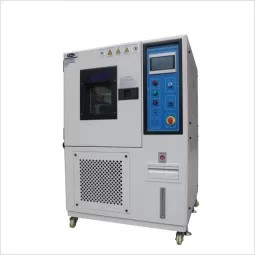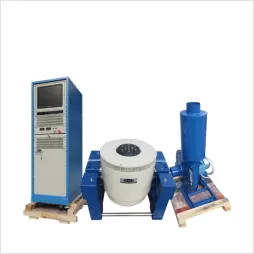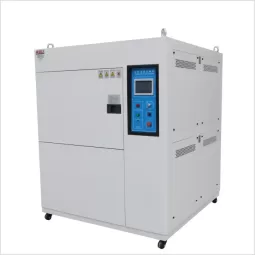High-Frequency Vibration Table Testing Issues and Solutions
Table of Contents
1. Introduction
High-frequency vibration tables are essential tools in industries such as automotive, aerospace, and electronics. They simulate the vibrations that products may encounter during transportation or operation, ensuring that they meet the necessary durability and reliability standards. However, there are common technical challenges faced during testing, such as mechanical failure, environmental limitations, and data inconsistencies. In this article, we explore these challenges and provide effective solutions.
2. Common Issues with High-Frequency Vibration Tables
2.1 Lateral Movement Issues
Cause Analysis:
Uneven vibration transfer results in instability in the test platform.
The design does not provide adequate lateral stiffness during high-frequency operation.
Impact:
Test data may deviate, leading to inaccurate results.
Failure to maintain stable test conditions, risking equipment damage.
2.2 Improper Accelerometer Installation
Cause Analysis:
Improper installation methods, such as insufficient fixation or incorrect mounting on the test surface.
Incorrect or unsuitable adhesives may lead to sensor detachment.
Impact:
Leads to inaccurate data and unreliable test results.
Non-repeatable results increase overall testing costs.
2.3 Resonance Phenomenon
Cause Analysis:
The natural frequency of the sample or fixture overlaps with the vibration frequency.
Lack of preliminary low-level sine scans to detect resonance points.
Impact:
Excessive stress on equipment may lead to premature failure.
Distortion of test data, compromising the accuracy of the tests.
2.4 Temperature Effects
Cause Analysis:
Overheating due to inadequate cooling systems during extended testing periods.
The material properties of the test sample or fixture may be temperature-sensitive, affecting performance.
Impact:
Accelerated aging and wear of the equipment.
Unstable test results, making data unreliable for future simulations.
3. Solutions to Issues
3.1 Solutions for Lateral Movement
Enhance platform design with high lateral stiffness to minimize movement.
Use precision fixtures to secure test samples firmly in place.
3.2 Improvements in Accelerometer Installation
Ensure proper installation by using high-quality adhesives or fixtures.
Regularly inspect sensors for any loose fittings or detachment.
3.3 Preventing Resonance Phenomenon
Conduct sine scans before testing to avoid resonance frequencies.
Adjust testing frequencies to stay away from the resonance zone.
3.4 Temperature Management and Control
Install advanced cooling systems to regulate the temperature during testing.
Use temperature-resistant materials for test samples and fixtures.
4. Testing Standards and Operational Considerations
4.1 Relevant Testing Standards
Standardized testing methods ensure the consistency and reliability of high-frequency vibration table results. Key standards include:
ISO 10816-1: Mechanical vibration — Evaluation of machine vibration by measurements on non-rotating parts.
IEC 60068-2: Environmental testing — Part 2: Tests.
4.2 Operational Considerations
Ensure adequate training for personnel handling the vibration tables.
Regularly calibrate equipment to maintain accuracy and reliability.
5. Maintenance and Care Techniques
5.1 Daily Maintenance
Perform daily checks to ensure the vibration table operates smoothly and that the test environment is optimal.
5.2 Regular Maintenance
Plan for periodic maintenance to identify wear and tear, replace any worn-out components, and recalibrate systems.
5.3 Tips and Best Practices
Always maintain proper cooling and ventilation systems.
Schedule regular inspections of all mechanical parts to prevent issues.
6. Case Studies and Data Reference
6.1 Case Study
Our case studies have shown significant improvement in testing accuracy after addressing common vibration table issues, leading to more reliable test results.
6.2 Typical Issue Data
Data from multiple tests show that issues such as lateral movement can cause up to 30% deviation in results without proper intervention.
6.3 Comparison of Different Equipment Performance
| Brand/Model | Frequency Range (Hz) | Maximum Acceleration (g) | Max Load (kg) | Control Accuracy (Hz) | Recommended Industry |
|---|---|---|---|---|---|
| ASLI A | 5 – 3,000 | 30 | 100 | ±0.01 | Consumer Electronics, Automotive |
| ASLI B | 10 – 10,000 | 50 | 200 | ±0.005 | Aerospace, Medical Devices |
| ASLI C | 1 – 5,000 | 20 | 50 | ±0.02 | Packaging, Transportation |
7. Conclusion and Future Outlook
High-frequency vibration table testing is critical to product development and validation. By addressing the common issues discussed and implementing solutions, testing processes can become more efficient, reliable, and cost-effective. The future lies in adopting automation, improving real-time data analysis, and further enhancing control systems.
8. References
ISO 10816-1: Mechanical vibration — Evaluation of machine vibration by measurements on non-rotating parts.
MIL-STD-810G: Environmental Engineering Considerations and Laboratory Tests.
IEC 60068-2: Environmental testing – Part 2: Tests.
9. Appendix
Vibration Table Daily Checklist
1. Equipment Appearance Check
Table Surface and Fixtures Check: Ensure the vibration table surface is free from damage, scratches, or unevenness. Verify that fixtures are secure and not loose.
Cables and Connections: Inspect all cables and connections for security and check for wear or damage.
Cooling System: Verify that the cooling fan or liquid cooling system is operating correctly. Ensure airways are clean and temperature control settings are properly configured.
Vibration Sensors: Ensure sensors are securely mounted, connections are good, and sensors are calibrated.
2. Mechanical Components Check
Drive System: Check for abnormal sounds from the motor and transmission system. Ensure sufficient lubrication.
Bearings and Rails: Inspect all rails and bearings for wear or excessive friction, ensuring smooth operation.
Shock Absorbing Pads and Supports: Check for damage to the shock pads and ensure supports are stable with no loosening or detachment.
3. Electrical System Check
Power Supply Check: Ensure the power supply is stable and meets requirements. Prevent overvoltage or undervoltage conditions.
Control Panel: Ensure that the vibration table control panel buttons and switches are functioning properly.
Signal Transmission: Verify that signals between the control system and vibration table are smooth, and that signal cables are free from interference.
4. Operational System Check
Software Updates: Ensure the vibration table control software is up to date. If updates are available, upgrade the software.
System Self-Test: Run the system self-test to verify the functionality of sensors, accelerometers, and other components.
Record Equipment Status: Ensure accurate recording of equipment operating status, including vibration frequency, acceleration, and other key data.
5. Temperature and Environmental Monitoring
Temperature Monitoring: Verify that the vibration table's operating temperature is within safe limits, and ensure no risk of overheating.
Environmental Conditions: Ensure that the testing environment’s temperature and humidity meet required standards to avoid any impact on test results.
Test Record Template
Test Information
| Test Date | November 20, 2024 |
|---|---|
| Operator | Zhang San |
| Device Model | XYZ-3000 High-Frequency Vibration Table |
| Test Objective | Automotive Electronic Module Vibration Test |
| Test Items | Vibration Frequency, Acceleration, Temperature, etc. |
| Test Environment | Temperature: 22°C, Humidity: 50% |
| Pre-Test Check | All daily checks completed, equipment status normal. |
Vibration Parameters
| Vibration Type | Sine Wave |
|---|---|
| Start Frequency | 10 Hz |
| End Frequency | 2000 Hz |
| Acceleration | 10 g |
| Vibration Direction | Three Axes (X, Y, Z) |
| Vibration Duration | 4 hours per axis |
Sample Information
| Sample ID | A12345 |
|---|---|
| Sample Description | Automotive Electronic Control Unit |
| Weight | 1.5 kg |
| Fixing Method | Fixed with dedicated fixtures |
Test Process
| Start Time | November 20, 2024 09:00 |
|---|---|
| End Time | November 20, 2024 13:00 |
| Test Frequency | 10 Hz – 2000 Hz, Stepwise Increase |
| Acceleration | 10 g, Axial Accelerometer Real-Time Monitoring |
| Environmental Temperature | 22°C, Humidity: 50% |
| Temperature Record | Mid-test Temperature: 24°C |
| Special Conditions | None |
Test Report Example
1. Test Objective: The objective of this test is to evaluate the vibration resistance of automotive electronic modules under simulated highway driving conditions to ensure the product can withstand long-term vibration stresses.
2. Test Equipment:
Vibration Table Model: XYZ-3000 High-Frequency Vibration Table
Accelerometer Model: ABC-123 High-Precision Accelerometer
Data Acquisition System: DEF-456 Data Acquisition System
3. Test Method: The test uses a sine wave vibration mode with a frequency range from 10 Hz to 2000 Hz and a maximum acceleration of 10 g. The vibration direction follows X, Y, and Z axes, each lasting for 4 hours.
4. Test Results:
X-axis: Maximum Acceleration 9.8g, Frequency Range: 10Hz - 2000Hz, No anomalies.
Y-axis: Maximum Acceleration 10.1g, Frequency Range: 10Hz - 2000Hz, Slight deviation, but no damage.
Z-axis: Maximum Acceleration 10.0g, Frequency Range: 10Hz - 2000Hz, No anomalies.
4.2 Temperature Data:
Initial Temperature: 22°C












